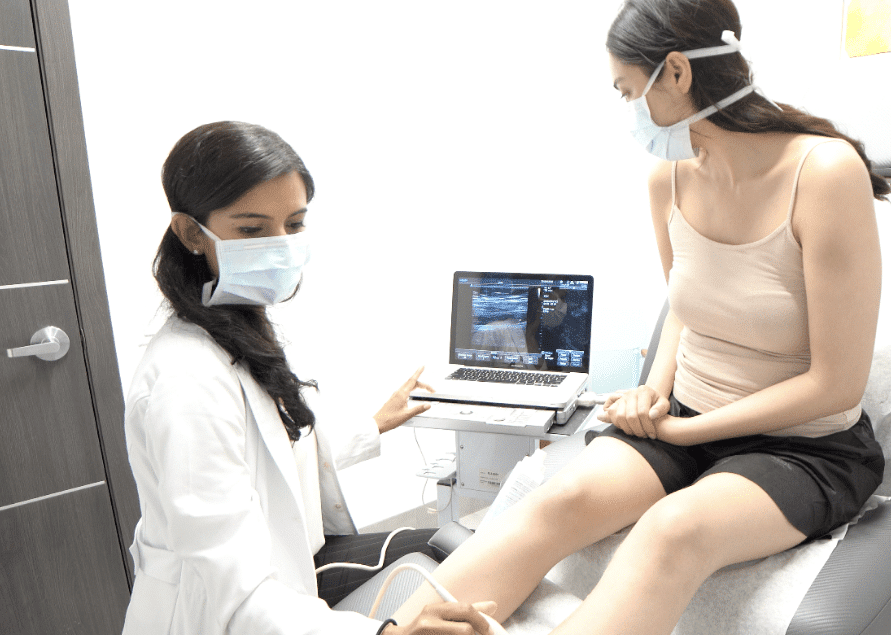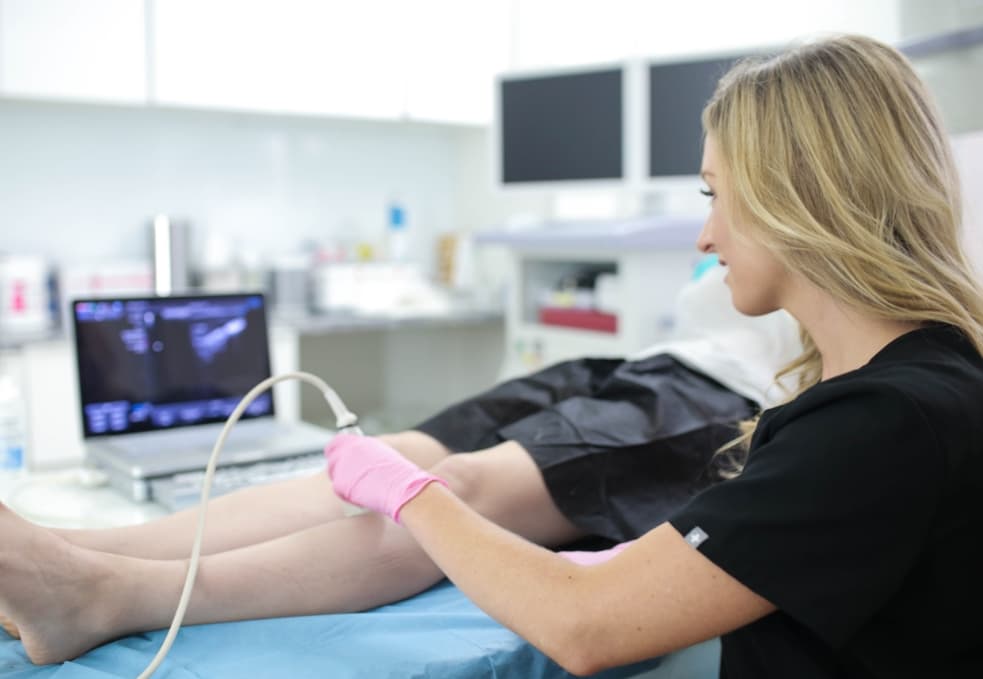The appearance of varicose veins in feet can cause significant self-consciousness and anxiety. And why wouldn’t it? No one wants to look down to find thick, dense, bulging, rope-like blood vessels protruding out of the skin’s surface. People with varicose veins often feel considerable self-consciousness and take special measures to hide and conceal their legs. You should never feel embarrassed about your appearance and skin — we offer effective solutions to eliminate unwanted varicose veins in the lower extremities and restore your confidence.
But to understand how to handle varicose veins in feet, you must first understand what they are. Maryland Vein Center offers personalized minimally invasive treatments to address the root cause of varicose veins in the lower extremity. Our board-certified vein doctors carefully examine your leg veins, discuss your symptoms, determine the root cause of varicose veins, and curate a personalized treatment plan. We have a convenient vein center in Maryland, just outside of Washington, DC. Please schedule an appointment for varicose vein treatments.
In this comprehensive guide, delve into the intricacies of varicose veins in feet.
What Are Varicose Veins in Feet?
Varicose veins are essentially damaged, bulging blood vessels that protrude out of the skin’s surface. These veins usually appear blue or purple and are often quite noticeable beneath the skin. Some patients describe varicose veins as dense tree trunks on their legs, and others say they look like a mass of thick, gnarled, knotted ropes. Varicose veins are usually larger than 3mm in diameter — if they’re smaller than 3mm, you may have reticular veins or spider veins.
Regardless of how varicose veins look, there’s no doubt about this: they cause self-consciousness and physical discomfort. Varicose veins in feet can lead to leg pain, heaviness, restless leg syndrome, and other symptoms. And if left untreated, varicose veins can continue expanding, eventually leading to potential complications like leg ulcers, skin discoloration, and deep vein thrombosis. And trust us, you don’t want to wait to find out what that’s like.
Varicose veins can appear anywhere on the body, but they commonly appear in the lower extremities, such as the legs and feet. So, the question arises, why are varicose veins in feet common? Why do you get varicose veins in the lower extremity?

Spider Veins & Varicose Veins in the Lower Extremity: A Lesson In Anatomy
To understand why you get varicose veins in the lower extremity, it’s essential to grasp the basics of the circulatory system. Veins are blood vessels responsible for returning deoxygenated blood from the body’s organs and tissues back to the heart. In the lower extremities, there is a network of veins, including deep veins and superficial veins, that work together to maintain proper blood circulation. The veins also contain tiny valves.
These tiny valves prevent the backward flow of blood, ensuring it moves in one direction—towards the heart. These vein valves essentially act like one-way doors, allowing blood to flow to the heart but not backward. When these valves become weak or damaged, blood can flow backward and pool within the veins, leading to their dilation and the development of varicose veins. While backward blood flow can happen anywhere in the body, it’s most likely to happen in the legs because gravity forces blood to flow backward, leading to varicose veins in feet.
Causes of Varicose Veins in Feet
The direct causes of varicose veins in feet are twofold: malfunctioning or damaged vein valves and gravity. As the vein valves weaken and collapse, gravity forces blood to flow backward and accumulate in the leg veins, eventually leading to varicose veins. However, the true root cause of varicose veins is a circulatory disorder known as chronic venous insufficiency.
Chronic venous insufficiency is a medical condition wherein the accumulation of blood in leg veins due to damaged vein valves leads to varicose veins. This is a chronic condition, which means it worsens with time. If you don’t seek treatment for varicose veins and chronic venous insufficiency, the symptoms will escalate and worsen. That’s why prompt treatment is crucial.
Common Risk Factors for Varicose Veins:
- Heredity: If both your parents had spider veins and varicose veins, there’s a 90% chance that you’ll also develop varicose veins at some point. That’s because some people have vein valves that are genetically predisposed to weakening.
- Age: Varicose veins are more common as you get older. Over time, the veins in your legs lose elasticity, leading to their enlargement and the formation of varicosities.
- Gender: If you’re female, we have tough news for you — you’re far more likely to get varicose veins and spider veins than men. Women have a higher risk of varicose veins because higher volumes of estrogen and progesterone can weaken the vein valves. Furthermore, pregnancy increases the risk of varicose veins.
- Prolonged Standing: Occupations that require long hours of standing or sitting can increase pressure in the veins of the lower extremities, potentially leading to varicose veins. Sitting or standing for long periods without breaks can impair blood circulation in the legs, contributing to vein issues.
Symptoms of Varicose Veins in Feet:
- Pain and Aching: Varicose veins can cause discomfort, ranging from a mild ache to severe pain, particularly after long periods of standing or sitting.
- Swelling: Your feet and ankles may swell, especially towards the end of the day.
- Visible Veins: You may notice twisted, bulging veins on the surface of your skin, typically in a bluish or purple hue. Varicose veins usually appear in the lower extremities.
- Itching and Burning: Some individuals experience itching and burning sensations.
- Restless Legs: You may suffer from restless leg syndrome, a condition wherein you have an insatiable urge to shake and move your legs and feet.
- Leg Cramps: Varicose veins can lead to frequent muscle cramps in the legs.
Diagnosing Varicose Veins in Feet
Before embarking on a treatment plan, it’s essential to diagnose the root cause of your varicose veins in the feet. At Maryland Vein Center, we prioritize accurate diagnosis through duplex ultrasound, a non-invasive imaging technique that provides detailed information about the blood flow in your veins. This helps us tailor a personalized treatment plan to address your specific condition. Treating varicose veins without a diagnosis isn’t recommended. If we don’t diagnose and treat underlying venous insufficiency, you’ll just get new varicose veins soon.
Treatment Options for Varicose Veins in Feet
Sclerotherapy
Sclerotherapy is a highly effective treatment for smaller varicose veins and spider veins in the feet. During this procedure, a solution is injected directly into the affected vein, causing it to close and gradually fade away. Sclerotherapy is minimally invasive, virtually painless, and typically requires little to no downtime.
Endovenous Laser Ablation (EVLA)
Endovenous Laser Ablation is a cutting-edge treatment that uses laser energy to seal off and close varicose veins in the feet. The vein doctor makes a small incision on your skin’s surface and inserts a catheter to destroy the damaged vein, rerouting accumulated blood to healthier veins. EVLA treats varicose veins and underlying vein disease.
Radiofrequency Ablation
Radiofrequency Ablation is another minimally invasive technique used to treat varicose veins. It involves the use of radiofrequency energy to heat and seal the affected veins, ultimately redirecting blood flow to healthier veins. Like EVLA, this procedure is performed on an outpatient basis, but it’s slightly more comfortable.
VenaSeal
VenaSeal is a revolutionary treatment that uses a medical adhesive to close varicose veins. This procedure is virtually painless and requires no tumescent anesthesia or heat, making it a comfortable option for many patients. Furthermore, since VenaSeal doesn’t involve thermal energy, the risk of nerve injury is minimal.
ClariVein
ClariVein is a combination technique that combines mechanical and chemical methods to treat varicose veins. A rotating wire is used to displace the lining of the vein while a special solution is simultaneously delivered to close the vein.
Ambulatory Phlebectomy
For larger varicose veins that are closer to the surface of the skin, ambulatory phlebectomy may be recommended. This procedure involves the removal of the affected vein through tiny incisions, resulting in minimal scarring.
Can Spider Veins Cause Leg Pain?
While spider veins are different from varicose veins, they can also cause discomfort in the lower extremities. Spider veins are smaller, dilated blood vessels that appear close to the surface of the skin, often in a web-like pattern. Although they are generally not painful, they can contribute to leg discomfort and aching sensations, especially when they are associated with underlying venous insufficiency.
If you are experiencing leg pain or discomfort, it’s essential to consult with a vein specialist to determine the underlying cause. At Maryland Vein Center, we offer comprehensive evaluations and diagnostic tests to identify the source of your symptoms and provide targeted treatment.
Preventive Measures and Lifestyle Changes:
- Stay Active: Regular physical activity encourages good blood circulation in the legs. Incorporate exercise into your daily routine to keep your veins healthy.
- Elevate Your Legs: Elevating your legs when resting or sleeping can help improve blood flow back to your heart and reduce swelling.
- Wear Compression Stockings: Compression stockings can provide support to your leg veins and help reduce discomfort and swelling associated with varicose veins.
- Take Breaks: If your job requires prolonged sitting or standing, make an effort to take breaks and move around regularly to encourage blood flow.
Maryland Vein Center: Your Partner in Vein Health
At Maryland Vein Center, we are committed to helping you achieve healthier, pain-free legs. Our board-certified vein doctors are experienced in diagnosing and treating varicose veins in the feet and other venous conditions. Visit our state-of-the-art facility conveniently located at 10215 Fernwood Rd, Suite 301, Bethesda, Maryland, just outside of Washington, DC in Silver Spring. Don’t let varicose veins in your feet hold you back. Contact us today to schedule a consultation and take the first step towards healthier, pain-free legs.





